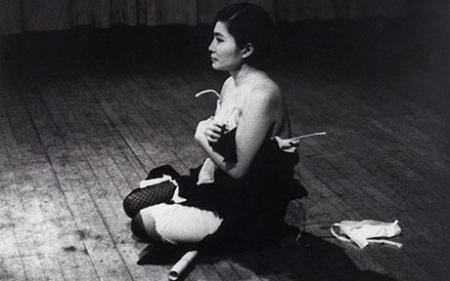To Androgyny
The inspiration for the title of my blog. The pose is known as ‘anasyromenos’, shown here by the figurine of Aphroditus, lifting up her dress to reveal the presence of male genitalia. The Greeks felt that the pose held apotropaic powers.
The impression of androgyny seems to be here enhanced by the ‘contrapposto’ stance of the figure, a more extreme form of which is the S-curve. Such a stance, with the greater part of a figure’s weight steadied by one foot, has been used in the representation of both genders in sculpture and painting. Many claim that the use of contrapposto marked the first use by Western art of the human body in the representation of a psychological disposition, with the informally balanced pose being taken as an indicator of a relaxed and mild manner. This artistic treatment seems to provide an early example of the recognition of similitude between the sexes, and their potential for combination.
Vagina Painting & Other Curiosities
I guess it wouldn’t be fair to use Jackson Pollock’s Autumn Rhythm as my header without also including a feminist response to his style of painting. Below is a photo of Shigeko Kubota’s Vagina Painting, wherein the artist paints red paint onto a sheet that has been laid on the floor. This is done using a paintbrush which has been attached to her crotch. The work was seen as a reaction against the phallocentrism of Pollock’s stick painting.
While I’m sharing artwork with the class, also of some interest would be Yoko Ono’s Cut Piece. Ono seats herself on the floor in front of her audience and then invites them to cut away her clothing. In this case, “vulnerability is here transformed into resistance, as her audience was forced to confront its own capacity for violence, both actual and phantasmic” (Foster, Art Since 1900).
Purblind Argus
“. . . he hath the joints of everything; but everything so out of joint that he is a gouty Briareus, many hands and no use; or purblind Argus, all eyes and no sight.” (Shakespeare, Troilus and Cressida, Act I-Scene II)
“She lay back compliantly and did not take her gaze from him so he was still trembling from her scrutiny as he entered her. But, even if they now acknowledged the state of love, their lovemaking was still permeated by unease for she understood the play of surfaces only superficially; she was like a blind man at a firework display who can only appreciate the fires in the air by interpreting their various degrees of magnificence through the relative enthusiasms of the noisy crowd. The nature of the dazzlement was dimly apprehended, not known.” (Carter 24)
In this passage Lee and Annabel “make love”, during the period shortly following the time when the two first meet. The two of them do not connect with each other as thoroughly as is possible given their level of physical intimacy. This theme, of estrangement in spite of intimacy, runs throughout the novel.
Angela Carter’s style throughout this passage supports a consistent interpretation. The emphasis here is on “surface” and superficiality. The “state” of love is “acknowledged”, rather than mutually felt and created. The imposition of the word “but” following the description of penetration is an anticlimax, and the recognition of love is safely contained within a subordinate clause and the passive voice, overshadowed by the active clause that follows it. The missed magnificence outshines the minor flares that are misapprehended. Annabel is compared to a blind man at a fireworks show, reliant upon external “relative enthusiasms” for the definition of something unseen. Lee and Annabel are only skimming the surface of an otherwise “unimaginable privacy”.
This passage stands out because it is a powerful treatment of the theme of the distance that can exist even in seemingly intimate situations. The struggle to bridge this distance is the ultimate undoing of the characters in Carter’s novel. Sex, in many situations in the novel, becomes divisive, rather than establishing common ground and empathic understanding. More generally, I think it is a shame that sexual relationships between men and women are so often abused, through infidelity, insincerity, and such things, introducing conflict and thereby sapping a large potentiality that could otherwise deepen and enhance bonds. Edmund Burke suggested that the “insensible swell” (Of the Sublime), the subtle variations in contour, near a woman’s neckline and shoulders, was a grand source for the inspiration of the sublime. I think he was right in his perception of depth, though pessimistic in his approximation of comprehensibility and incorrect in his emphasis on terror rather than wonder. So much potential for wasted sight.
Women & Literature
Hi everyone! My name is Andrew, and I’m looking forward to taking this class over the summer. I find the concept of femininity to be both captivating and elusive, and thinking about these ideas will provide a much-needed respite from economics!
I’ve long been interested in the issues that women face during wartime, and the unique role that they could potentially play in post-conflict reconstruction efforts. If possible, I would like to incorporate some of these dynamics into the material that we will be discussing for class.



